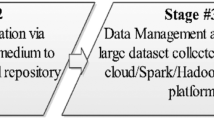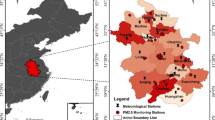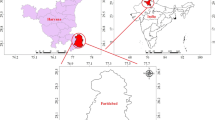Abstract
The development of industrial civilization has greatly enriched the material and spiritual life of human beings, but it is accompanied by the intensification of the consumption of earth resources and environmental pollution. The smog that has emerged in various parts of China in recent years is a typical problem, which not only endangers human health but also affects normal human work and life. It is difficult to control smog in a short time productively, so people need to understand the rule of smog formation gradually, and effectively predict the PM2.5 index to help people continuously analyze relevant mechanisms and timely protect-related hazards. This paper proposes a hybrid model that uses the Complementary Ensemble Empirical Modal Decomposition algorithm to mine the information in the original PM2.5 sequence and then predicts the pertinent random forests. The trend of PM2.5 concentration during the decomposition process is effectively reflected, and the decomposition sequence is modeled by the high tolerance of the random forest to the noise data and the good fitting ability. In the modeling process, the parameters are optimized according to the evaluation function of the model on the verification set, and eventually, the prediction sequences are superimposed to obtain the final predicted PM2.5 concentration value. The validity of the model is verified by the data of several Chinese cities with different geographical features in the past 5 years. The results show that the recommendation model is higher than other comparison models in terms of model stability and prediction accuracy.









Similar content being viewed by others
References
Appel KW et al (2017) Description and evaluation of the community multiscale air quality (CMAQ) modeling system version 5.1 geoscientific model. Development 10:1703–1732
Bai Y, Li Y, Wang X, Xie J, Li C (2016) Air pollutants concentrations forecasting using back propagation neural network based on wavelet decomposition with meteorological conditions. Atmos Pollut Res 7:557–566. https://doi.org/10.1016/j.apr.2016.01.004
Bai Y, Zeng B, Li C, Zhang J (2019) An ensemble long short-term memory neural network for hourly PM2.5 concentration forecasting. Chemosphere 222:286–294
Biancofiore F et al (2017) Recursive neural network model for analysis and forecast of PM10 and PM2.5 atmospheric. Pollut Res 8:652–659
Breiman L (2001) Random forests
Chelani AB (2018) Estimating PM2.5 concentration from satellite derived aerosol optical depth and meteorological variables using a combination model atmospheric pollution research
Chen G, Li S, Knibbs LD, Hamm NAS, Cao W, Li T, Guo J, Ren H, Abramson MJ, Guo Y (2018) A machine learning method to estimate PM2.5 concentrations across China with remote sensing, meteorological and land use information. Sci Total Environ 636:52–60
Cheng Y, Zhang H, Liu Z, Chen L, Wang P (2019) Hybrid algorithm for short-term forecasting of PM2.5 in China. Atmos Environ 200:264–279
Cobourn WG (2010) An enhanced PM2.5 air quality forecast model based on nonlinear regression and back-trajectory concentrations. Atmos Environ 44:3015–3023
Feng X, Li Q, Zhu Y, Hou J, Jin L, Wang J (2015) Artificial neural networks forecasting of PM2.5 pollution using air mass trajectory based geographic model and wavelet transformation. Atmos Environ 107:118–128
Franceschi F, Cobo M, Figueredo M (2018) Discovering relationships and forecasting PM10 and PM2.5 concentrations in Bogota, Colombia, using artificial neural networks, principal component analysis, and k-means clustering. Atmos Pollut Res 9:912–922
Gan K, Sun S, Wang S, Wei Y (2018) A secondary-decomposition-ensemble learning paradigm for forecasting PM2.5 concentration atmospheric. Pollut Res 9:989–999
Garcia D (2010) Robust smoothing of gridded data in one and higher dimensions with missing values. Comput Stat Data Anal 54:1167–1178
Guo L et al (2018) Improving PM2.5 forecasting and emission estimation based on the Bayesian optimization method and the coupled FLEXPART-WRF model. Atmosphere 9
Huang NE et al (1998) The empirical mode decomposition and the Hilbert spectrum for nonlinear and non-stationary time series analysis proceedings. Math Phys Eng Sci 454:903–995
Huang K, Xiao Q, Meng X, Geng G, Wang Y, Lyapustin A, Gu D, Liu Y (2018) Predicting monthly high-resolution PM2.5 concentrations with random forest model in the North China plain. Environ Pollut 242:675–683
Liang X, Li S, Zhang S, Huang H, Chen SX (2016) PM2.5 data reliability, consistency, and air quality assessment in five Chinese cities. J Geophys Res Atmos 121:10220–10236
Liu D, Niu D, Wang H, Fan L (2014) Short-term wind speed forecasting using wavelet transform and support vector machines optimized by genetic algorithm. Renew Energy 62:592–597
Liu J et al (2016) Air pollutant emissions from Chinese households: a major and underappreciated ambient pollution source. Proc Natl Acad Sci U S A 113:7756–7761
Liu D, Sun K, Huang H, Tang P (2018) Monthly load forecasting based on economic data by decomposition integration theory. Sustainability:10
Luo M, Hou X, Gu Y, Lau N-C, Yim SH-L (2018) Trans-boundary air pollution in a city under various atmospheric conditions. Sci Total Environ 618:132–141
Mahajan S, Chen LJ, Tsai TC (2018a) Short-term PM2.5 forecasting using exponential smoothing method: a comparative analysis. Sensors (Basel) 18. https://doi.org/10.3390/s18103223
Mahajan S, Liu H-M, Tsai T-C, Chen L-J (2018b) Improving the accuracy and efficiency of PM2. 5 forecast service using cluster-based hybrid neural network model. IEEE Access 6:19193–19204
Miao Y, Guo J, Liu S, Liu H, Li Z, Zhang W, Zhai P (2017) Classification of summertime synoptic patterns in Beijing and their associations with boundary layer structure affecting aerosol pollution. Atmos Chem Phys 17:3097–3110
Moisan S, Herrera R, Clements A (2018) A dynamic multiple equation approach for forecasting PM2.5 pollution in Santiago, Chile. Int J Forecast 34:566–581
Niu M, Wang Y, Sun S, Li Y (2016) A novel hybrid decomposition-and-ensemble model based on CEEMD and GWO for short-term PM2.5 concentration forecasting. Atmos Environ 134:168–180
Qi Y, Li Q, Karimian H, Liu D (2019) A hybrid model for spatiotemporal forecasting of PM2.5 based on graph convolutional neural network and long short-term memory. Sci Total Environ 664:1–10
Requia WJ, Adams MD, Arain A, Papatheodorou S, Koutrakis P, Mahmoud M (2018) Global association of air pollution and cardiorespiratory diseases: a systematic review, meta-analysis, and investigation of modifier variables. Am J Public Health 1082:S123–S130
Shang Z, Deng T, He J, Duan X (2019) A novel model for hourly PM2.5 concentration prediction based on CART and EELM. Sci Total Environ 651:3043–3052
Sofiev M et al (2018) Cleaner fuels for ships provide public health benefits with climate tradeoffs. Nat Commun:9
Tang G, Zhang J, Zhu X, Song T, Münkel C, Hu B, Schäfer K, Liu Z, Zhang J, Wang L, Xin J, Suppan P, Wang Y (2016) Mixing layer height and its implications for air pollution over Beijing, Chins. Atmos Chem Phys 16:2459–2475
Tang L, Nagashima T, Hasegawa K, Ohara T, Sudo K, Itsubo N (2018) Development of human health damage factors for PM2.5 based on a global chemical transport model. Int J Life Cycle Assess 23:2300–2310
Torres ME, Colominas MA, Schlotthauer G, Flandrin P (2011) Complete ensemble empirical mode decomposition with adaptive noise. In: IEEE International Conference on Acoustics
Wang S, Li Q, Fang C, Zhou C (2016) The relationship between economic growth, energy consumption, and CO2 emissions: empirical evidence from China. Sci Total Environ 542:360–371
Wang P, Zhang H, Qin Z, Zhang G (2017) A novel hybrid-Garch model based on ARIMA and SVM for PM2.5 concentrations forecasting. Atmos Pollut Res 8:850–860
Xu Y, Yang W, Wang J (2017) Air quality early-warning system for cities in China. Atmos Environ 148:239–257
Yan D, Lei Y, Shi Y, Zhu Q, Li L, Zhang Z (2018) Evolution of the spatiotemporal pattern of PM2.5 concentrations in China - a case study from the Beijing-Tianjin-Hebei region. Atmos Environ 183:225–233
Yang B, Guo J, Xiao C (2018) Effect of PM2.5 environmental pollution on rat lung. Environ Sci Pollut Res 25:36136–36146
Zhang B, Jiao L, Xu G, Zhao S, Tang X, Zhou Y, Gong C (2018a) Influences of wind and precipitation on different-sized particulate matter concentrations (PM2.5, PM10, PM2.5-10). Meteorol Atmos Phys 130:383–392
Zhang L, Lin J, Qiu R, Hu X, Zhang H, Chen Q, Tan H, Lin D, Wang J (2018b) Trend analysis and forecast of PM2.5 in Fuzhou, China using the ARIMA model. Ecol Indic 95:702–710
Zhou C, Chen J, Wang S (2018) Examining the effects of socioeconomic development on fine particulate matter (PM2.5) in China's cities using spatial regression and the geographical detector technique. Sci Total Environ 619:436–445
Zhou Y, Chang F-J, Chang L-C, Kao IF, Wang Y-S, Kang C-C (2019) Multi-output support vector machine for regional multi-step-ahead PM2.5 forecasting. Sci Total Environ 651:230–240
Zhu J, Lee RW, Twum C, Wei Y (2019) Exposure to ambient PM2.5 during pregnancy and preterm birth in metropolitan areas of the state of Georgia. Environ Sci Pollut Res 26:2492–2500
Author information
Authors and Affiliations
Corresponding author
Additional information
Responsible editor: Constantini Samara
Publisher’s note
Springer Nature remains neutral with regard to jurisdictional claims in published maps and institutional affiliations.
Rights and permissions
About this article
Cite this article
Liu, D., Sun, K. Short-term PM2.5 forecasting based on CEEMD-RF in five cities of China. Environ Sci Pollut Res 26, 32790–32803 (2019). https://doi.org/10.1007/s11356-019-06339-9
Received:
Accepted:
Published:
Issue Date:
DOI: https://doi.org/10.1007/s11356-019-06339-9




